How do LaFolio Badges work with the e-Portfolio?
The LaFolio e-Portfolio and Badge Network function in tandem. Together they engage students in a reflective learning process and prepare them to be citizens, schola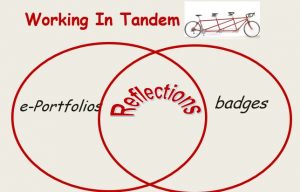 rs, and leaders.
rs, and leaders.
- The e-portfolio functions as a blueprint and presents an agile inventory of choices and opportunities that students might explore during their college years.
- The badge credential is a holistic means of assessing and showcasing key features of a student’s e-portfolio. From the student’s perspective, the badges cognitively chunk their learning experiences so that they have a metacognitive understanding of their educational journey.
*The wide-spread use of electronic badges for learning was first articulated as part of the Mozilla Open Badge Initiative in collaboration with the MacArthur Foundation in 2012.
| Overview•LaFolio Badges•Applying•Adjudication•Reflection |
l.Why earn a badge ?
- For Lafayette’s latest, mobile-technology generation of students and alums, badges are credentials that can be easily and quickly linked to professional social media sites, like Linked-in, and displayed in their LaFolio portfolio “power resumes”.
- They complement the traditional transcript and GPA.
- And, importantly, research shows:
“…the expanded use of digital badges can improve learning and outcomes for students and adults. The digital credentials represent an individual’s skills, interests, and achievements. They can be used to convey core academic knowledge as well as other modern day competencies that can’t be measured by traditional assessments.”
—-Alliance for Excellent Education. August, 2013. http://www.macfound.org
What is a badge anyway?
- A way to assess and applaud the development of:
- Knowledge
- Skills
- Abilities
- Achievements
- A tool to help teachers and means for learners to recognize:
- What they know.
- What they can do.
- Where they can go next.
- A learning instrument that promotes deep learning and reflection.
ll. How many LaFolio badges are there? Which one is for languages?

There are currently LaFolio badges representing skill development and mastery in seven different domains: i-Lead, i-Lingua, i-World, i-Think, i-Create, i-Tools, and wii-Connect. ALL are for learners of languages!
Indeed, i-Lingua assesses communicative competence, but all the domains represent skills and achievements that language learners develop as they become more and more proficient. And, like the e-portfolio blueprint, the LaFolio badge also provides a focal point and scaffolds learning over time, helping students set milestones and goals: ruby, silver, and gold.
- Ruby=good
- Silver=strong
- Gold=exemplary.
- There is also a Pearl badge—for the first step.
Students can earn badges as part of a capstone experience, but, thanks to the milestones, are encouraged to build their competency in numerous areas over the course of their college career. Ideally, the badge process is introduced to 1st or 2nd year students, who apply for pearls or rubies and, in consultation with advisors and professors, map out learning experiences that help them fulfill silver and gold criteria . Advising is a key part of this process.
How is the LaFolio badge different from many other badges?
Although typical badges are one dimensional–showing participation in a single activity or event, the Lafolio badges that we are beta-testing are meta badges and represent a complex system– learning!
The LaFolio badges are based on the AAC & U Value Rubrics and ACTFL 5 C’s; they serve as criteria for reviewing and assessing the Lafayette College e-Portfolios. Badge rubrics are classified by domains, in other words, sets of skills, achievements, and experiences.
Badge Rubric Correspondences with National Standards:
| i-Lingua |
|
| i-World | Intercultural Knowledge & Competence and Global Learning VALUE Rubrics |
| i-Lead | Civic Engagement and Teamwork VALUE Rubrics |
| i-Create | Creative Thinking VALUE Rubric |
| i-Think | Critical Thinking VALUE Rubric |
| i-Tech | Technology Literacy |
| LaFolio | Integrative Learning VALUE Rubric |
| *Valid Assessment of Learning in Undergraduate Education (VALUE Rubrics) | |
lll. How can a student earn a badge?
Evidence: Students have already taken the first step in the badge process by developing their portfolios. The criteria for badges is based on evidence students have archived in their portfolios.
The Application: When applying for a badge, students are asked 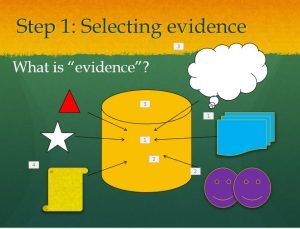 to reflect on their work and select a certain number of artifacts as supporting evidence to their application. The number of artifacts or evidence selected depends on the badge and the milestone the student is seeking.
to reflect on their work and select a certain number of artifacts as supporting evidence to their application. The number of artifacts or evidence selected depends on the badge and the milestone the student is seeking.
Let’s take the i-World badge as an example. For the i-World Ruby, three artifacts or pieces of evidence are required: For the i-World Silver, four artifacts are required:
For the i-World Silver, four artifacts are required:
 For the i-World Gold, five artifacts are required.
For the i-World Gold, five artifacts are required.
Why multiple artifacts? We ask students to give several examples of work because research shows us that there is an interactivity between artifacts. One artifact in isolation has no context and could be misinterpreted. For the same reason, all artifacts should be nested with reflections in your personal e-Portfolio (K. Yates-Glancy, B. Cambridge)
Criteria: Students fulfill certain criteria for earning a badge—the criteria increases in complexity according to the milestone the student wishes to achieve. There are six criteria possibilities for the i-World badge; this badge and criteria map interdisciplinary knowledge, intercultural competence, and global learning.

Students DO NOT HAVE TO FULFILL ALL 6 criteria but only the required criteria for the milestone. This flexibility, encourages sustained learning and development over the course of a student’s college tenure. For, the i-World Sliver credential, just 3 categories of THEIR choice: 3 categories with a performance rating at the silver level . Students select which criteria their work exemplifies.
lV. Awarding the Badge: An Exercise in Adjudication
How would you rate the student application (below) for the silver milestone of the i-World badge? Given the evidence she provides does it meet the silver level standards for the Communications criteria for the badge?
Steps in the adjudication process.
- Read the criteria in iWorld Rubric .
- Read the evidence (2 parts) normally found in the e-Portfolio.
- Read the reflection (found in student’s presentation, not included here).
Note: for the purpose of this exercise, a synopsis of the criteria and evidence have been provided.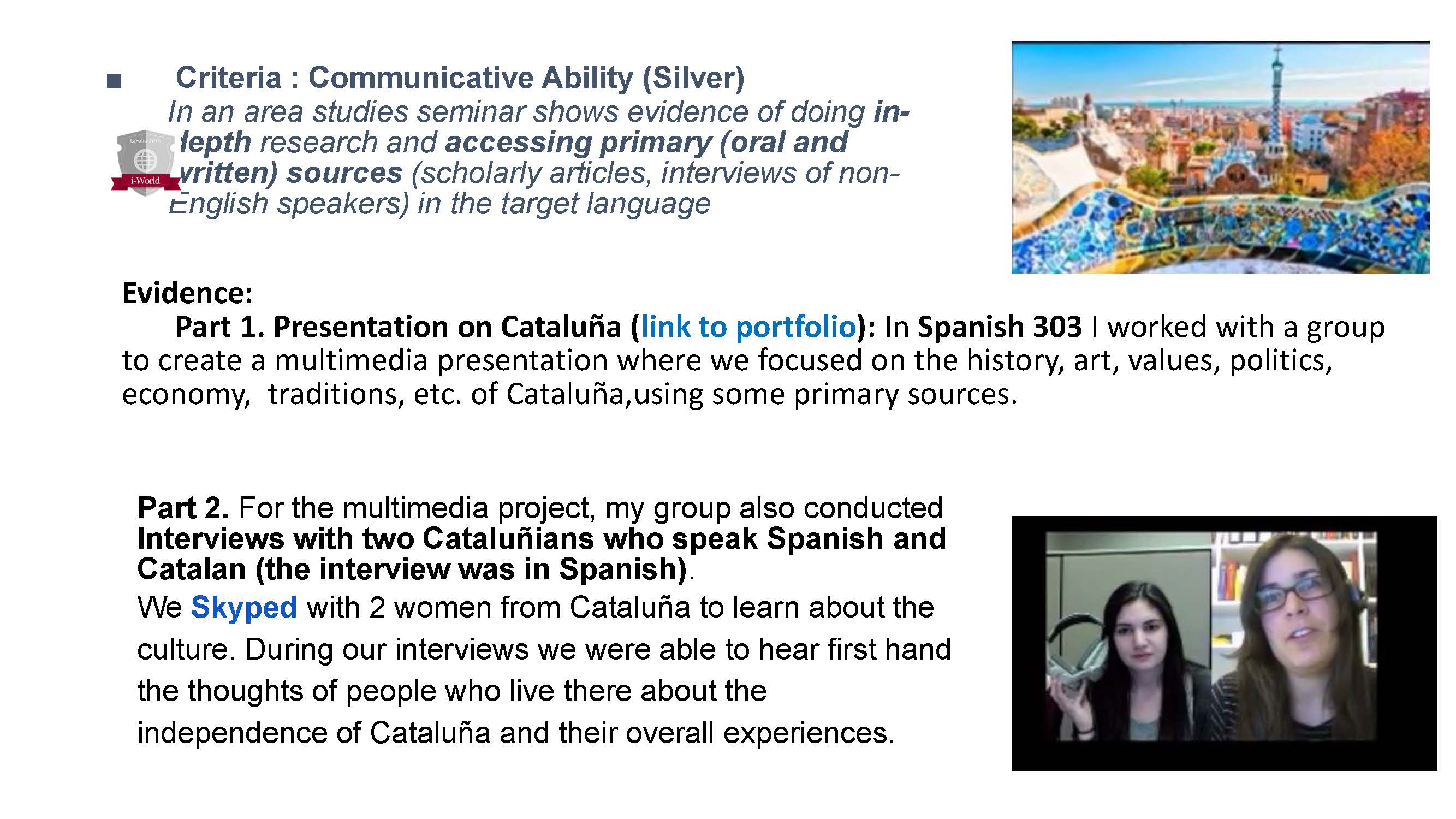
V. Reflections and Reflection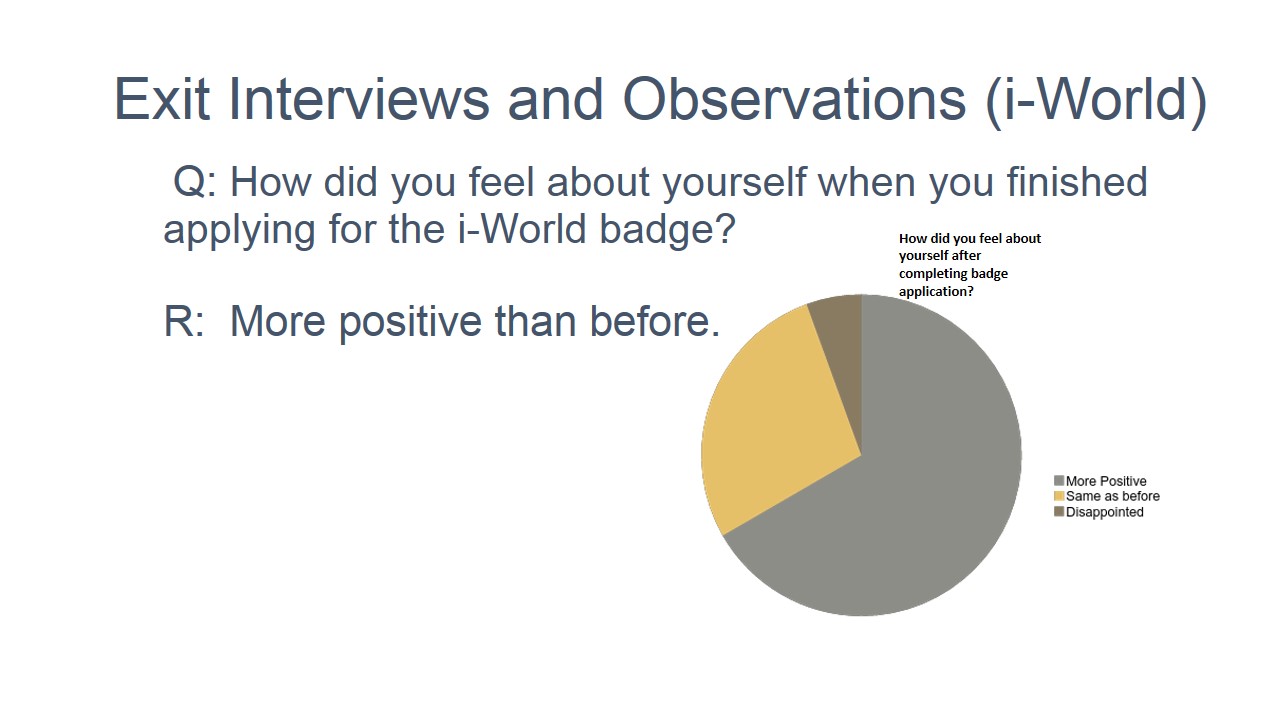
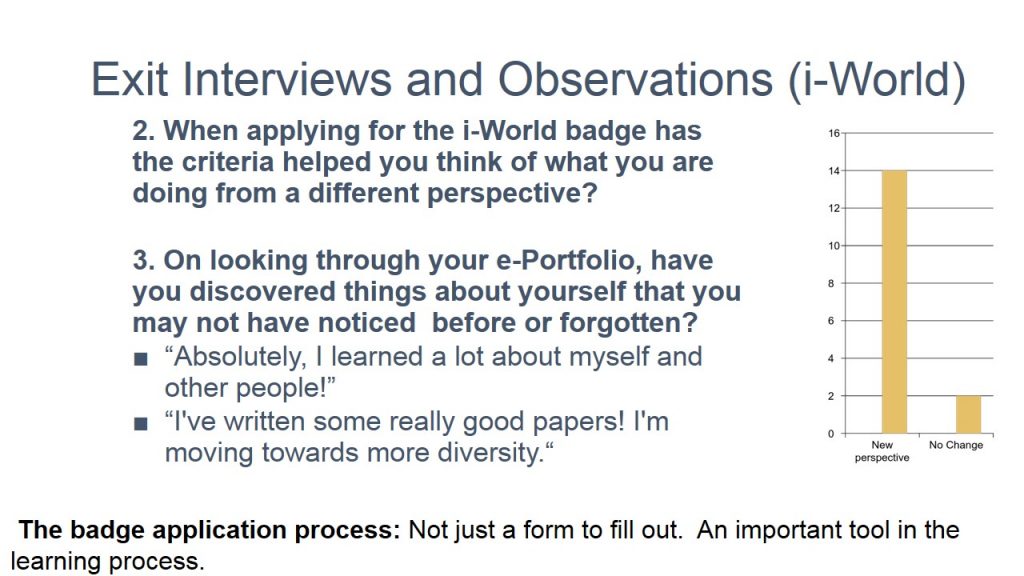
Our exit interviews and the observation of students applying for badges seem to indicate that the double entry, even third entry process of the LaFolio badge, used in conjunction with the e-Portfolio, promotes deep learning through multiple phases of reflection such as that described by Hans Georg Gadamer. Indeed, as noted in the iWorld rubric descriptor, the badge is designed to encourage a critical analysis of personal engagement with complex, global systems.
The results of our beta-testing of badges over the last three years are positive: they indicate engagement and scalability across campus (and even farther) through the tie-in with the Mozilla Open Badges platform as well new curricular and transcurricular opportunities.
